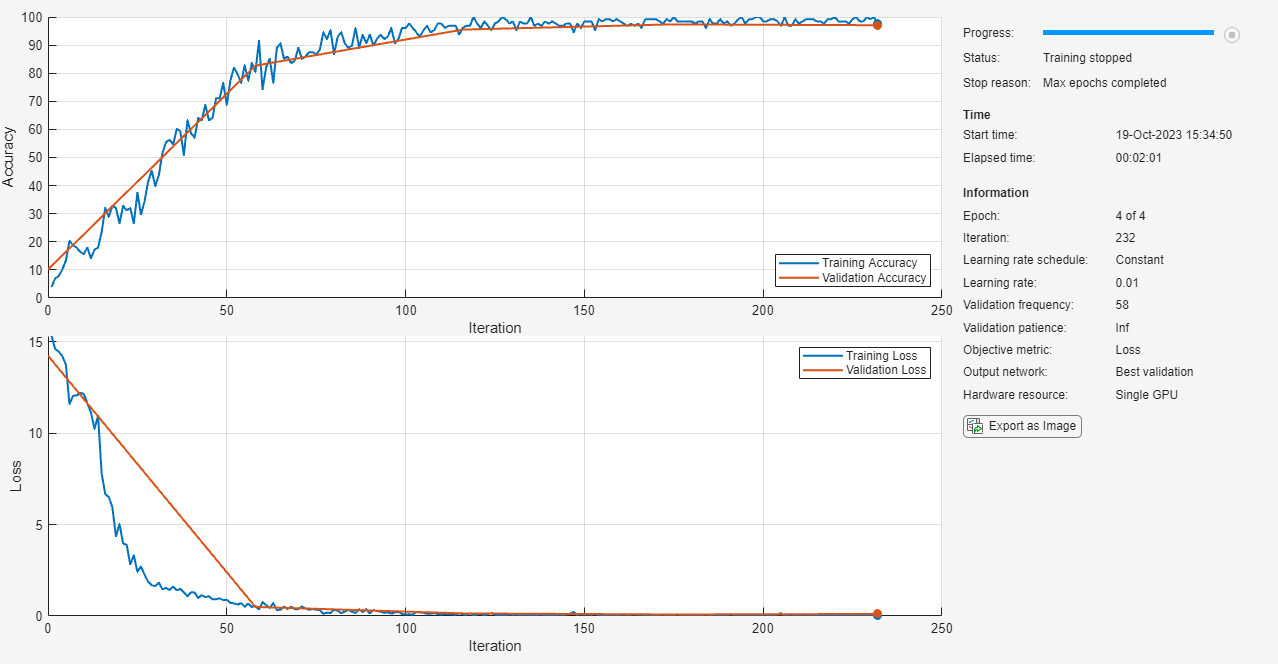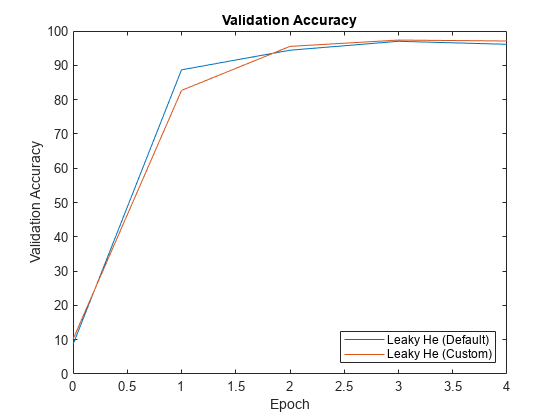Specify Custom Weight Initialization Function
This example shows how to create a custom He weight initialization function for convolution layers followed by leaky ReLU layers.
The He initializer for convolution layers followed by leaky ReLU layers samples from a normal distribution with zero mean and variance , where a is the scale of the leaky ReLU layer that follows the convolution layer and n = FilterSize(1) * FilterSize(2) * NumChannels.
For learnable layers, when setting the options WeightsInititializer, InputWeightsInitializer, or RecurrentWeightsInitializer to "he", the software uses a=0. To set a to different value, create a custom function to use as a weights initializer.
Load Data
Load the digit sample data as an image datastore. The imageDatastore function automatically labels the images based on folder names.
unzip("DigitsData.zip"); imds = imageDatastore("DigitsData", ... IncludeSubfolders=true, ... LabelSource="foldernames");
Divide the data into training and validation data sets, so that each category in the training set contains 750 images, and the validation set contains the remaining images from each label. splitEachLabel splits the datastore into two new datastores for training and validation.
numTrainFiles = 750;
[imdsTrain,imdsValidation] = splitEachLabel(imds,numTrainFiles,"randomize");Create Custom Weight Initialization Function
The leakyHe function takes the input sz (the size of the layer weights) and returns an array of weights given by the He Initializer for convolution layers followed by a leaky ReLU layer. The function also accepts the optional input argument scale which specifies the scale multiplier for the leaky ReLU layer.
function weights = leakyHe(sz,scale) % If not specified, then use default scale = 0.1 if nargin < 2 scale = 0.1; end filterSize = [sz(1) sz(2)]; numChannels = sz(3); numIn = filterSize(1) * filterSize(2) * numChannels; varWeights = 2 / ((1 + scale^2) * numIn); weights = randn(sz) * sqrt(varWeights); end
Define Network Architecture
Define the convolutional neural network architecture:
Image input layer size of
[28 28 1], the size of the input imagesThree 2-D convolution layers with filter size 3 and with 8, 16, and 32 filters respectively
A leaky ReLU layer following each convolutional layer
Fully connected layer of size 10, the number of classes
Softmax layer
For each of the convolutional layers, set the weights initializer to the leakyHe function.
inputSize = [28 28 1];
numClasses = 10;
layers = [
imageInputLayer(inputSize)
convolution2dLayer(3,8,WeightsInitializer=@leakyHe)
leakyReluLayer
convolution2dLayer(3,16,WeightsInitializer=@leakyHe)
leakyReluLayer
convolution2dLayer(3,32,WeightsInitializer=@leakyHe)
leakyReluLayer
fullyConnectedLayer(numClasses)
softmaxLayer];Train Network
Specify the training options and train the network. Train for four epochs. To prevent the gradients from exploding, set the gradient threshold to 2. Validate the network once per epoch. Display the training progress in a plot and monitor the accuracy.
Train the neural network using the trainnet function. For classification, use cross-entropy loss. By default, the trainnet function uses a GPU if one is available. Training on a GPU requires a Parallel Computing Toolbox™ license and a supported GPU device. For information on supported devices, see GPU Computing Requirements (Parallel Computing Toolbox). Otherwise, the trainnet function uses the CPU. To specify the execution environment, use the ExecutionEnvironment training option.
maxEpochs = 4; miniBatchSize = 128; numObservations = numel(imdsTrain.Files); numIterationsPerEpoch = floor(numObservations / miniBatchSize); options = trainingOptions("sgdm", ... MaxEpochs=maxEpochs, ... MiniBatchSize=miniBatchSize, ... GradientThreshold=2, ... ValidationData=imdsValidation, ... ValidationFrequency=numIterationsPerEpoch, ... Verbose=false, ... Metrics="accuracy", ... Plots="training-progress"); [netDefault,infoDefault] = trainnet(imdsTrain,layers,"crossentropy",options);

Test Network
Test the neural network using the testnet function. For single-label classification, evaluate the accuracy. The accuracy is the percentage of correct predictions. By default, the testnet function uses a GPU if one is available. To select the execution environment manually, use the ExecutionEnvironment argument of the testnet function.
accuracy = testnet(netDefault,imdsValidation,"accuracy");Specify Additional Options
The leakyHe function accepts the optional input argument scale. To input extra variables into the custom weight initialization function, specify the function as an anonymous function that accepts a single input sz. To do this, replace instances of @leakyHe with @(sz)leakyHe(sz,scale). Here, the anonymous function accepts the single input argument sz only and calls the leakyHe function with the specified scale input argument.
Create and train the same network as before with the following changes:
For the leaky ReLU layers, specify a scale multiplier of 0.01.
Initialize the weights of the convolutional layers with the
leakyHefunction and also specify the scale multiplier.
scale = 0.01;
layers = [
imageInputLayer(inputSize)
convolution2dLayer(3,8,WeightsInitializer=@(sz)leakyHe(sz,scale))
leakyReluLayer(scale)
convolution2dLayer(3,16,WeightsInitializer=@(sz)leakyHe(sz,scale))
leakyReluLayer(scale)
convolution2dLayer(3,32,WeightsInitializer=@(sz)leakyHe(sz,scale))
leakyReluLayer(scale)
fullyConnectedLayer(numClasses)
softmaxLayer];
[netCustom,infoCustom] = trainnet(imdsTrain,layers,"crossentropy",options);
Test the network using the testnet function.
accuracy = testnet(netCustom,imdsValidation,"accuracy");Compare Results
Extract the validation accuracy from the information output from the trainnet function.
validationAccuracy = [
infoDefault.ValidationHistory.Accuracy, ...
infoCustom.ValidationHistory.Accuracy];For each of the networks, plot the epoch numbers against the validation accuracy.
figure epochs = 0:maxEpochs; plot(epochs,validationAccuracy) title("Validation Accuracy") xlabel("Epoch") ylabel("Validation Accuracy") legend(["Leaky He (Default)" "Leaky He (Custom)"],'Location','southeast')

Bibliography
He, Kaiming, Xiangyu Zhang, Shaoqing Ren, and Jian Sun. "Delving deep into rectifiers: Surpassing human-level performance on imagenet classification." In Proceedings of the IEEE international conference on computer vision, pp. 1026-1034. 2015.
See Also
trainnet | trainingOptions | dlnetwork